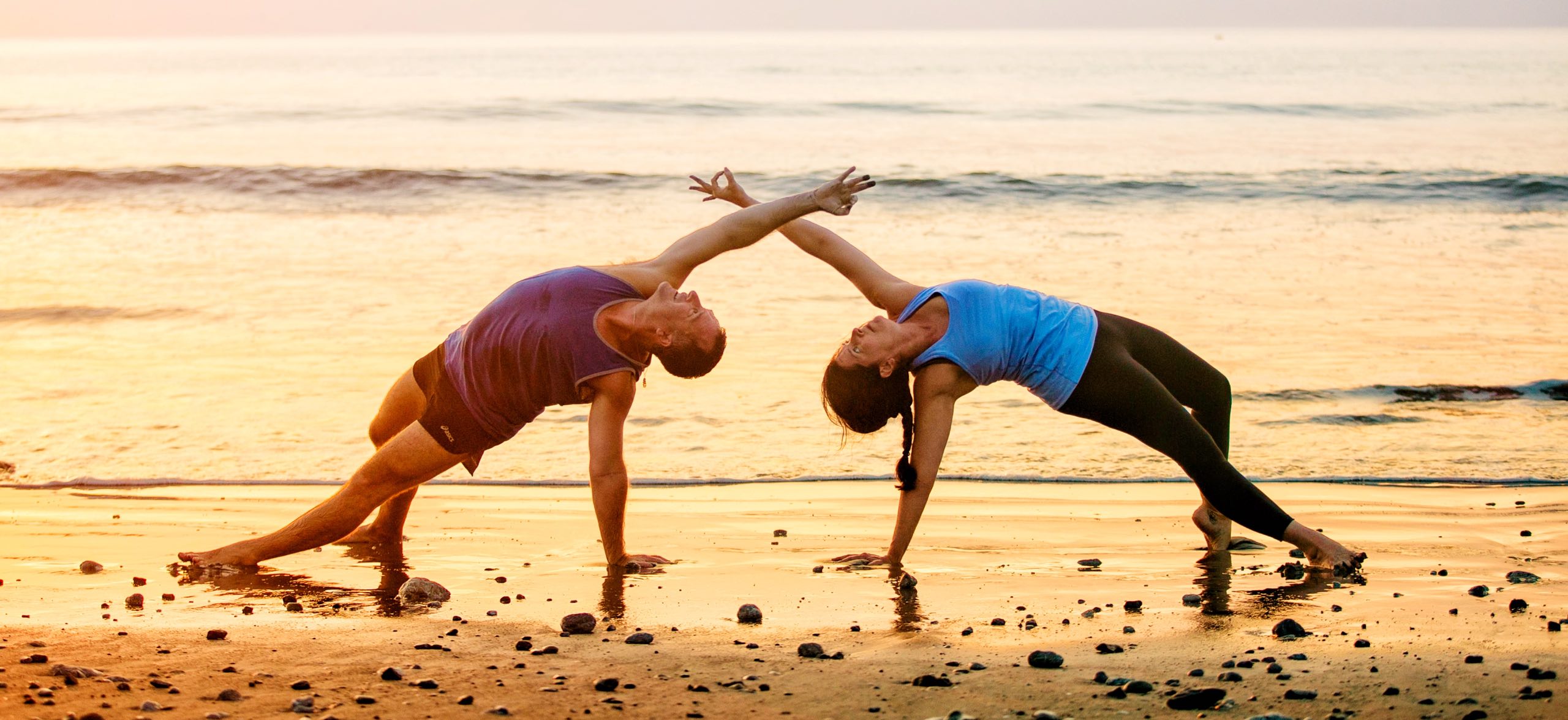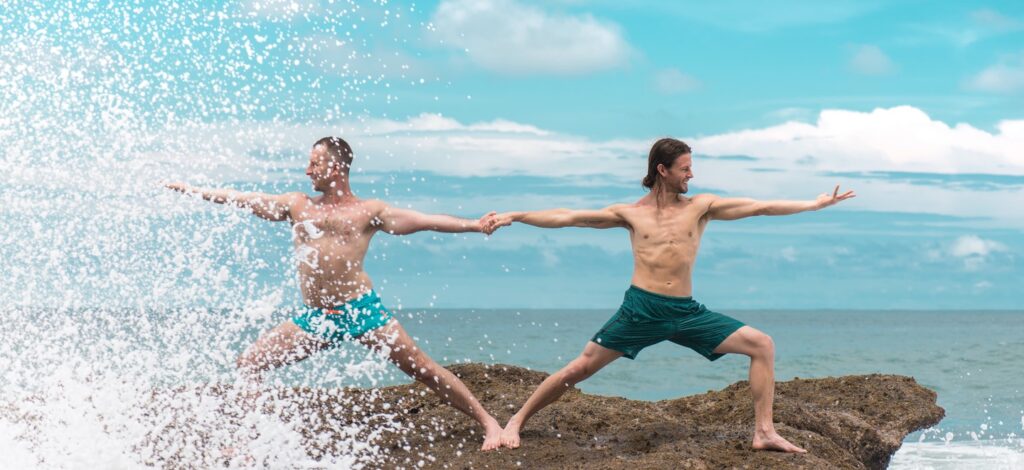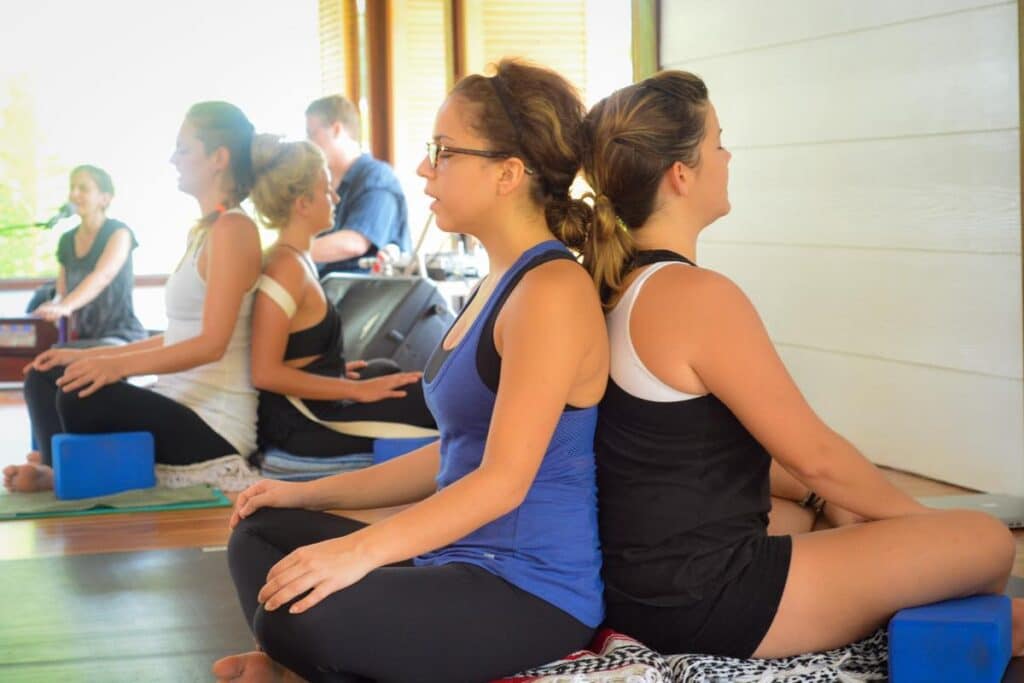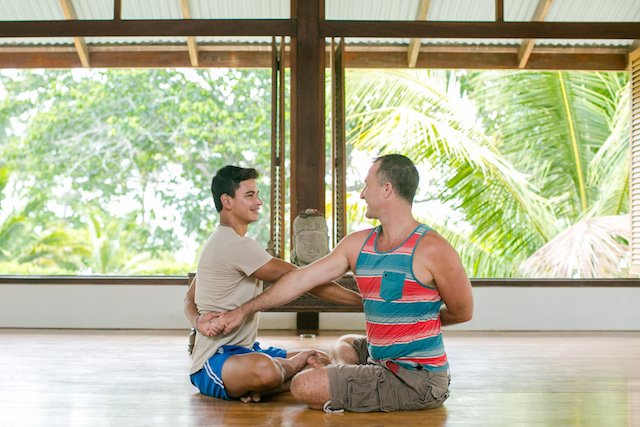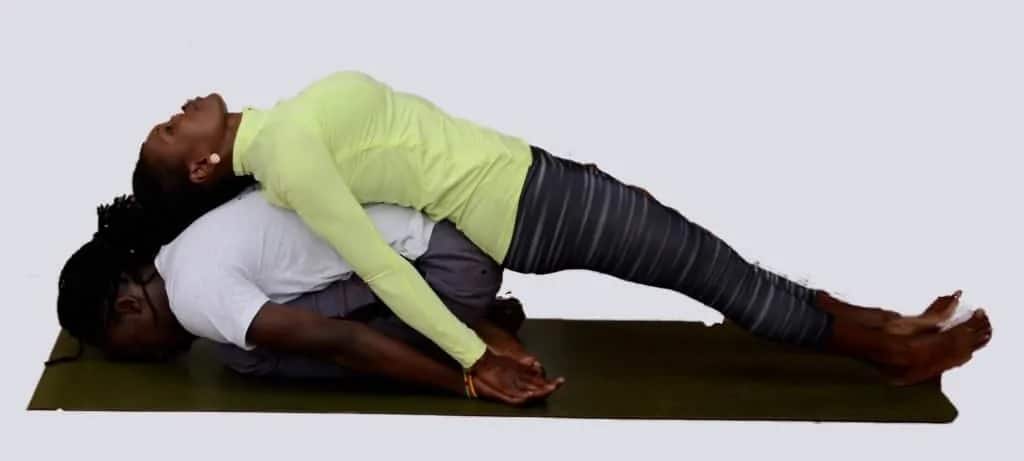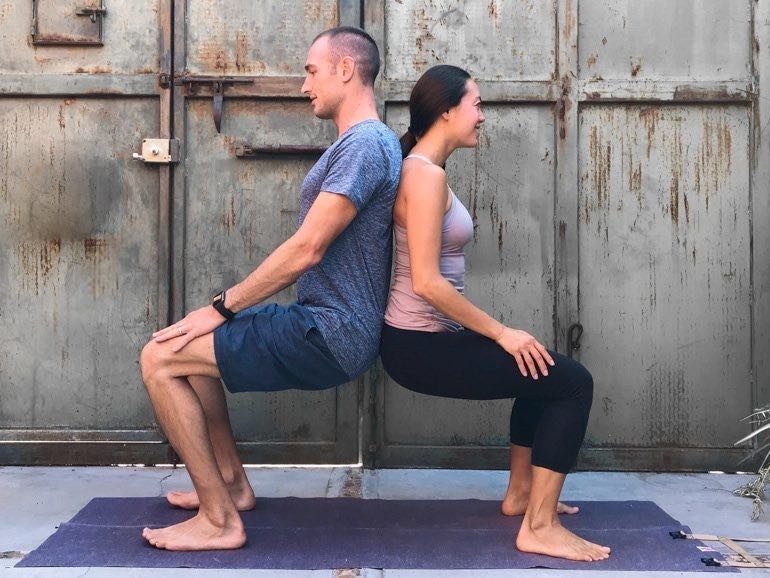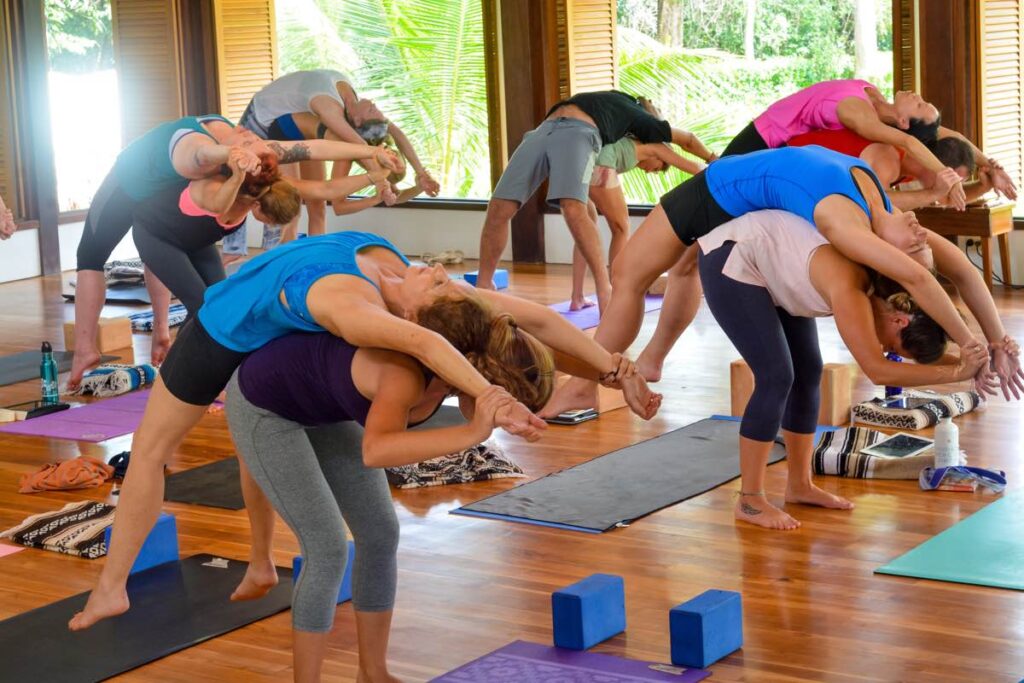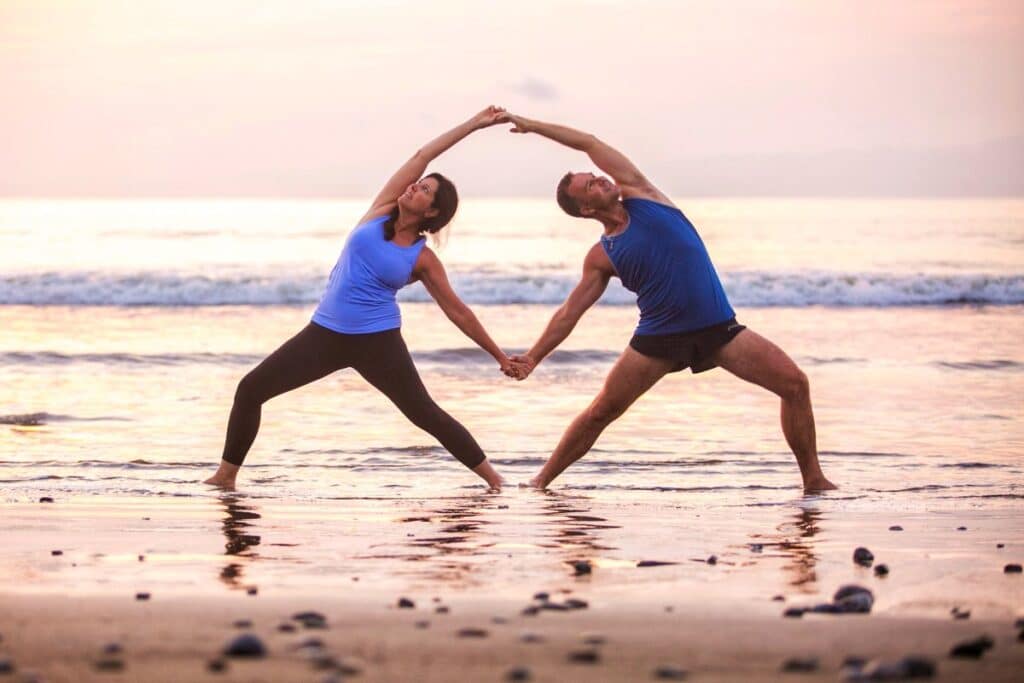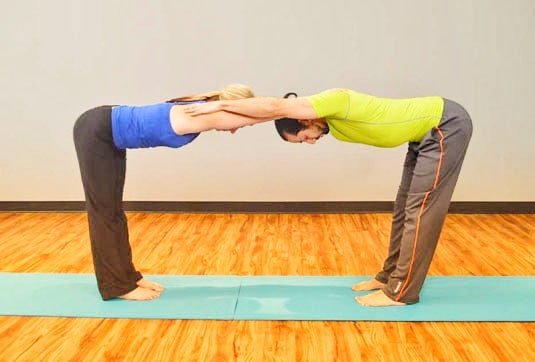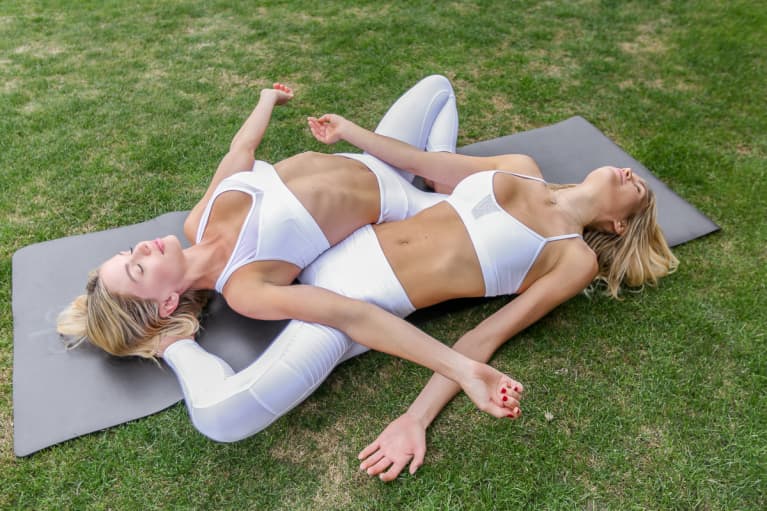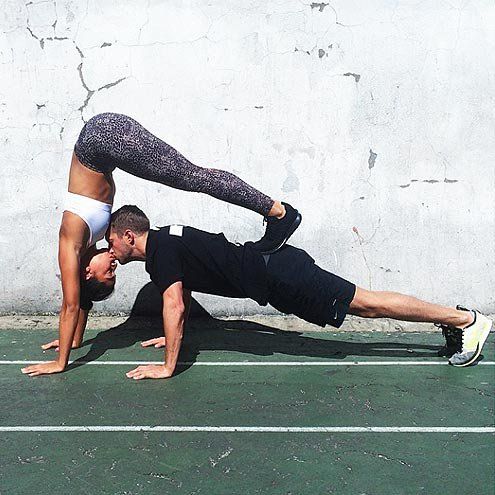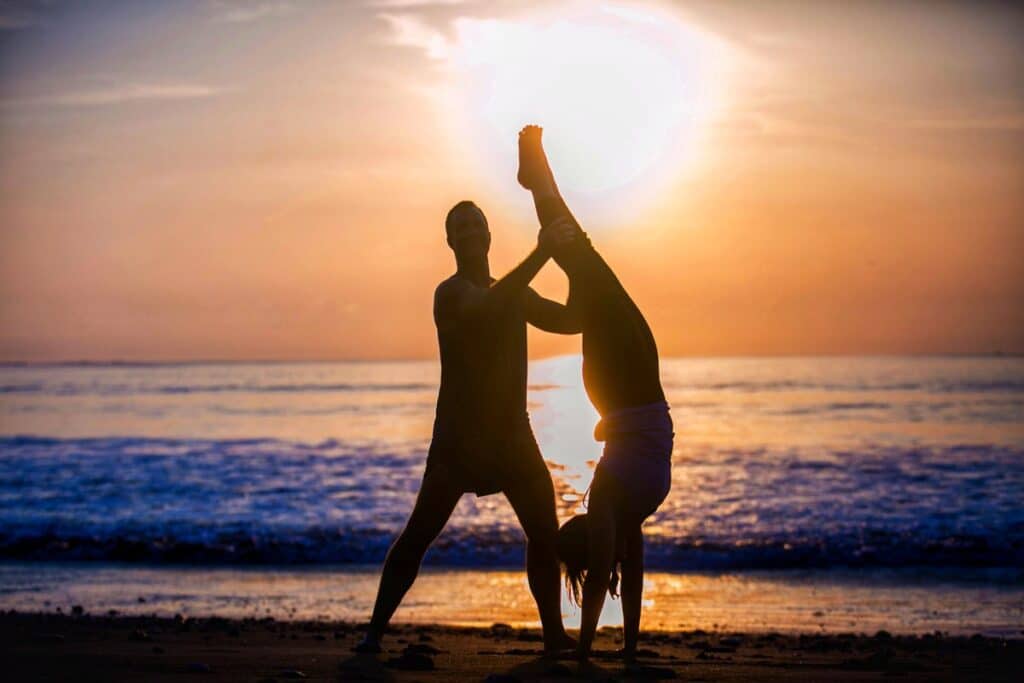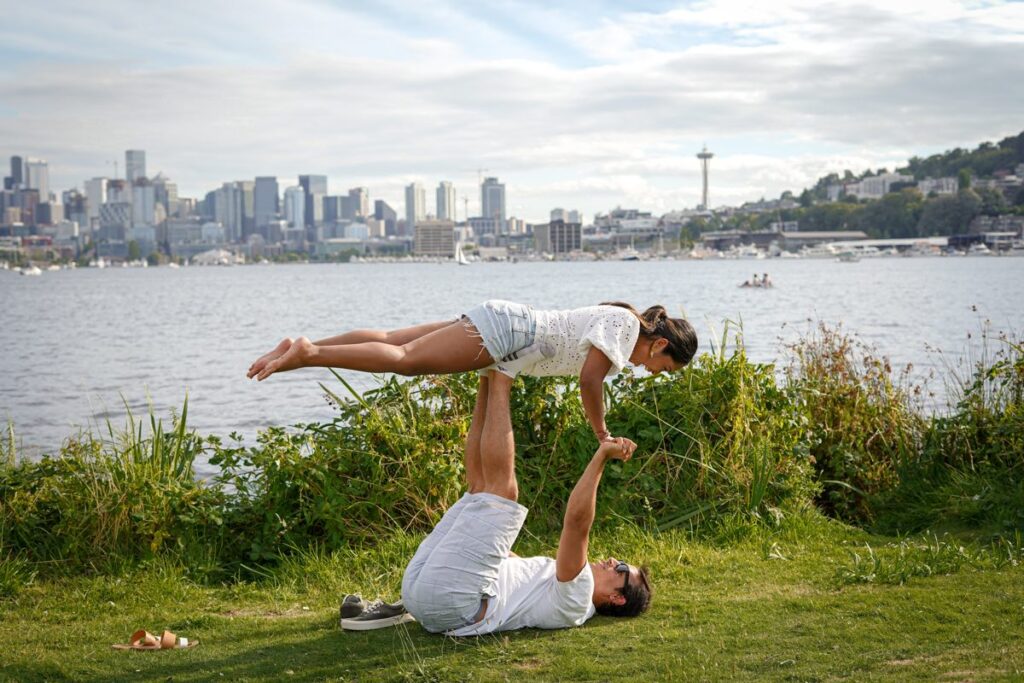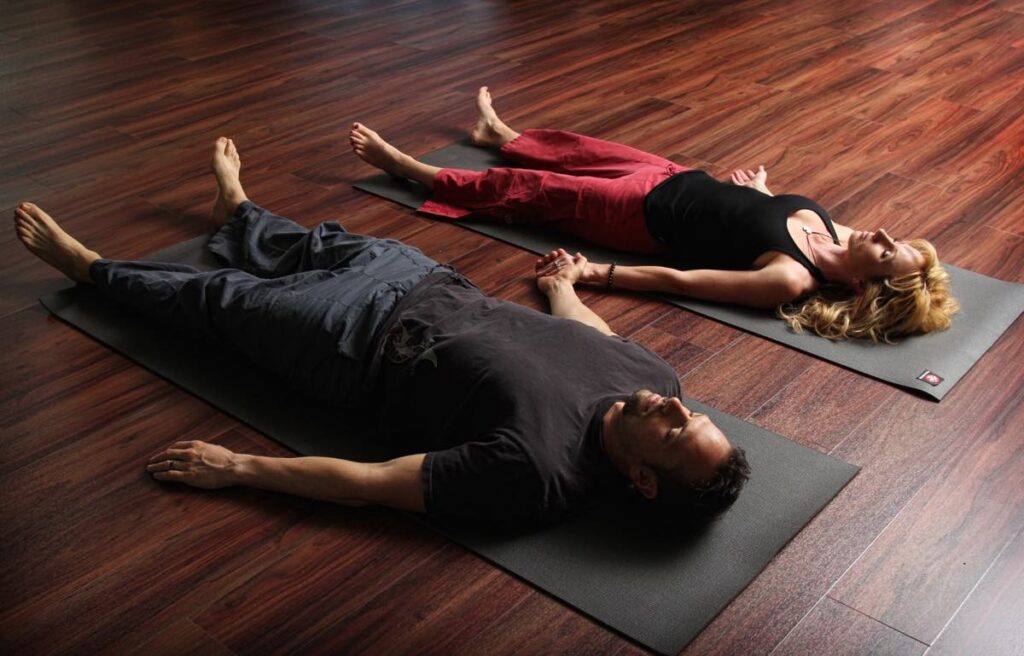If you’re looking to spice up your yoga practice, yoga poses for two people might be something to try.
Partner yoga poses offer a powerful way to move deeper into postures. Plus, you’ll build trust, strengthen your emotional connection with your partner, and have fun, too! Now, I know some of you are thinking: “Partner yoga sounds great, but I’m not in a relationship. And I’m not so sure this is second-date material.”
Don’t worry — partner yoga isn’t just for couples. You can practice these yoga poses for two people with friends, family, roommates, and even book a yoga spa vacation for you and your favorite yoga partner.
Anyone is invited, so long as you have safe relationships with mutually agreed-upon boundaries.
Partner yoga poses are exciting to try, but they come with so many other benefits. Let’s take a closer look at the advantages of trying yoga poses with a partner, then introduce some of my favorite two-person yoga poses
What is Partner Yoga?
Partner yoga is just as the name suggests — a style of yoga in which two people support one another in each pose. Some two person yoga poses include hands-on assists, while others focus on synchronizing the breath.
The Benefits of Yoga Poses With a Partner
Inviting someone else into your yoga practice to try out yoga poses for two people can be deeply impactful. The same way yoga fosters a connection with the self, it does between two people.
1. Two-Person Yoga Poses Are Fun!
If your Downward Dog has you feeling uninspired, hitting the mat with a buddy might be what you need to find your yoga groove. Plus, studies show that engaging in play releases endorphins, improves brain functionality, and stimulates creativity.
2. Partner Yoga Poses Enhance Posture
Sometimes, we all need a little support. This goes for learning yoga, too! Partner yoga poses are a great way to learn how to accept support. Maybe your partner is gently guiding you deeper into a posture. Or, perhaps they’re providing some much-needed balance as you root down on one leg.
When you practice yoga poses with two people, you uniquely experience the asanas — and that’s a very good thing.
3. Partner Yoga Builds Relationships
Partner yoga requires trust and communication. There is a degree of intimacy in couple yoga poses; you’ll want to pay attention to your partner and openly express any boundaries or limitations. If you’ve ever wondered how couples do yoga poses, this is it!
Learning to lean on your partner (quite literally) has far-reaching benefits both on and off the mat.
4. Partner Yoga Builds Trust
Practicing yoga poses designed for two people means you must rely on someone else to hold you, support you, and provide you with balance. Many poses can be a bit challenging and daunting. This encourages trust in your partner that they literally and figuratively have your back.
Performing yoga with another means you often have to give up control which can be a good trait to learn in real life. The trust you build with your friend or partner in yoga will often carry over to your life off the mat.
5. Partner Yoga Allows You to Open Up
Yoga asana often brings you into vulnerable positions. Practicing yoga poses for two people means allowing the energy of another person into this space of vulnerability.
Those with insecurities such as body image issues can learn to accept and love their bodies by opening them up for others to see in detail. Yoga with a friend or partner also offers you both to be present in a relaxed setting where you can learn to laugh and not take life so seriously.
6. Partner Yoga Creates Intimacy Through Touch
Practicing yoga with two people can be intimidating for some in the beginning, as it involves a great deal of close contact and touching. Touch is a strong component of developing close connections with people. Yoga for two can help you increase your awareness of each other by way of touch. Performing yoga with another person brings awareness to each other in a way that transcends just physical presence.
For couples, the physical touch of yoga can lead to a greater sense of intimacy. This may expand into other areas of your relationship and help you deepen your connection.
7. Partner Yoga Creates Shared Memories & Strengthens Bonds
Just as quality time can bring you closer to loved ones, so can practicing yoga together. Yoga is a light-hearted activity that will allow you both to smile while boosting physical and mental health. Yoga provides an open atmosphere that makes the time you share with your friend or partner memorable.
Many of the yoga poses you will perform together help you build a solid foundation with your bodies. In turn, this will help to further strengthen your relationship’s foundation.
8. Partner Yoga Provides Physical and Emotional Support
Although we may be well aware of the many physical and mental benefits of yoga, it can be daunting to dive into it alone. Breaking into the practice of yoga with yoga poses for two people can help give you the extra motivation and support you need to make yoga a part of your routine.
We tend to accomplish far more when we learn to support one another. Recognizing how being able to rely on someone else provides positive results, you will be more willing to engage closely with others in many aspects of your life. This is just one of many partner yoga benefits.
Tips for Practicing Partner Yoga Poses
To be successful in practicing yoga poses with a partner, consider the following tips:
- Openly communicate. Express any physical limitations or boundaries before getting started. Maintain open communication throughout the practice.
- Actively listen. Not just to your partner’s words, but to their movements and body queues, too. You never want to push or pull your yoga buddy into a pose that doesn’t feel right.
- Let go of the ego. Yoga is an ongoing practice of dissolving the Ego. This applies to yoga poses for two people. You’re not trying to impress your partner or prove your flexibility. Instead, focus on the process and find joy in each pose — whatever that looks like for you today.
Acroyoga vs Partner Yoga
What’s the difference between Acroyoga and partner yoga?
To put it simply, acroyoga is a type of partner yoga. It involves yoga, acrobatics, and Thai massage to create a playful, therapeutic practice. Acroyoga might look complex, but there are practices for all levels.
I’ve included one of my favorite Acroyoga poses below. It’s great for beginners and an excellent way to explore if Acroyoga is for you.
20 Yoga Poses For Two People
Find a friend and grab your mats — it’s time to give these partner yoga poses a try!
These 20 yoga poses for two people are suitable for all levels, beginner through advanced. Remember to always listen to your body, and modify as necessary.
1. Seated Meditation
Before diving into these yoga poses for two people, take a moment to connect with your partner.
Find a comfortable back-to-back seat. Inhale and extend through your spine. Exhale and ground down, plugging your sit bones into the mat beneath you.
Start to match your breath. After a few moments, try the opposite — inhale while your partner exhales (and vice versa.) Continue this mindful breathwork until you both feel calm, grounded, and present.
You can also use this time to set an intention for your practice and send a positive affirmation to your partner.
2. Seated Twist
One of my favorite easy yoga poses for two people is this seated twist. This is a smart start to any partner yoga flow.
Sit cross-legged and back-to-back. Inhale to lengthen and grow tall through the spine. On the exhale, begin to twist. Place your right hand on your left knee. Take your left hand to your partner’s right knee.
Using your partner’s knee for support, gently twist deeper with each exhale. Come back to center on an inhale. Switch sides.
3. Seated Forward Fold + Backbend
This yoga pose for two people also begins from a back-to-back, cross-legged posture.
Now, reach your arms overhead and hold hands with your partner. On the exhale, begin to fold forward — gently pulling your partner into a backbend. Your partner’s head will relax on your upper back; you can lightly tug on your partner’s hands for an extra stretch through the shoulders and forearms.
Use the breath to move deeper into the postures, only going as far as comfortable for both participants. Switch.
4. Seated Forward Fold + Fish Pose
Stay back-to-back with your partner and extend your legs in front of you. This pose is similar to the last but will focus on opening up the chest and hamstrings.
Move into a forward bend as your partner reclines into a fish pose variation. I suggest relaxing the hands on the floor, palms facing up towards the sky. Your partner’s head and torso will lie on your upper back as they open through the heart center. Switch.
5. Child’s Pose + Fish
Come into child’s pose by kneeling on your mat with your toes together and knees slightly apart. Inhale to lengthen the spine. Exhale and walk your hands forward until your chest is resting on the ground or thighs.
Your partner now sits on your sacrum (facing away from you) and lies back on your upper body. They can extend their arms overhead. If there’s no pain in the lower back, they can stretch out their legs, too.
This yoga pose for two people is deeply restorative, so you might want to stay in it for a while! I recommend at least 8 – 10 breaths (so long as both individuals are comfortable.) Switch.
6. Boat Pose
Ready to fire up your core with one of my favorite hard yoga poses for two people?
Yeah, I know — boat pose can be tricky, and most of my students loathe it. But a strong core stabilizes your whole body. Plus, abdominal work is always more fun with a buddy, so let’s give it a go!
Face your partner and bring your toes together. Now, grab onto your partner’s arms. Keep the spine long as you both lift your legs. Scooch front or back as needed.
Raise the shins, so they’re parallel to the mat. Or, for a challenge, straighten the legs into a complete boat pose. Try not to round the back — and don’t forget to smile, too.
7. Chair Pose
Chair pose is one of those two person yoga poses that’s got a handful of variations. So, I’m gonna share a few of my favorites:
Standing Face-to-Face:
1 . Grab onto your partner’s hands or forearms.
2 . Sink back into your heels while keeping the knees stacked over the ankles.
3 . Work towards bringing the thighs parallel to the mat and your shoulders in line with your knees.
It might feel like you’re about to fall on your bum, but don’t worry! Your partner is there to support you.
Revolved Chair: Maintain the same position as above, but grab your partner’s opposite hand. (e.g., your right hand holds their right hand, too.) Extend the other hand behind you, palm out. Take the gaze to the back hand for a lovely spinal twist. Switch.
Standing Back-to-Back:
1 . Stand back-to-back and link arms with your partner.
2 . On the exhale, sink into your chair pose.
3 . Walk your feet out as needed, so you both come fully into the posture. If no one has knee pain, play with dropping down to the ground and rising back up.
4 . Don’t release the arms for one heck of a challenge.
8. Double Downward Dog
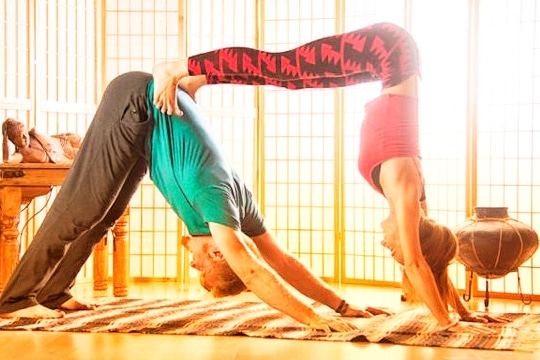
No list of yoga poses for two people is complete without a classic double Downward Dog, and it’s for a good reason. You’ll lengthen through the spine and stretch out those hammies — more than you might on your own.
Start in a Downward Dog. Lift the tailbone up to the sky as you spread your fingers wide and press firmly through the pads and knuckles. Bend your knees as needed to keep the spine long.
Your partner takes a Downward Dog, too, but with their feet on your lower sacrum. Ask your partner to bend one knee, then the other, gently massaging your lower back. They can apply pressure with their feet to create more space in your lower back. Or, have them guide your hip bones towards your knees for a juicy hamstring stretch. Switch.
9. Supported Wheel
This is a gentle yet powerful heart-opening posture — and it’s one I love!
Stand back-to-back with your partner and link arms. Start to bend forward while sending your hips back. Your partner will move with you, releasing fully on your back until their feet come off the ground.
If it’s comfortable, let go of the arms and sway side to side. Your partner will breathe entirely through the whole front body as they let their torso melt onto yours. Switch.
10. Reverse Warrior II
Face away from each other for this partner yoga pose. Now move into Warrior II; if your partner steps forward with their right foot, do the same. Slide your back hand down your leg, then bring it to rest on your partner’s back leg (avoiding the knee.)
At the same time, sweep your front hand overhead. Pause. Inhale through the side body and your partner’s top hand. Use each other’s grip to move deeper into the backbend, adjusting the feet as necessary. Try this yoga pose for two people on the other side.
11. Standing Shoulder Opener
Now stand face-to-face. Place your hands on your partner’s shoulders. Elongate your spine long and keep your arms straight, and begin to walk the feet back. Keep going until your torsos are parallel with the ground. Keep space through the back shoulders and let go of any tension in the chest.
How does this feel?
For a fun play on Warrior III, lift one leg until it’s parallel with the ground. Or, try Half Moon. Switch sides.
Pro Tip: Who says your yoga buddy needs to be a person? Use the back of a chair to achieve the same shoulder-opening benefits. It feels extra good if you slump at your desk all day!
12. Standing Backbend
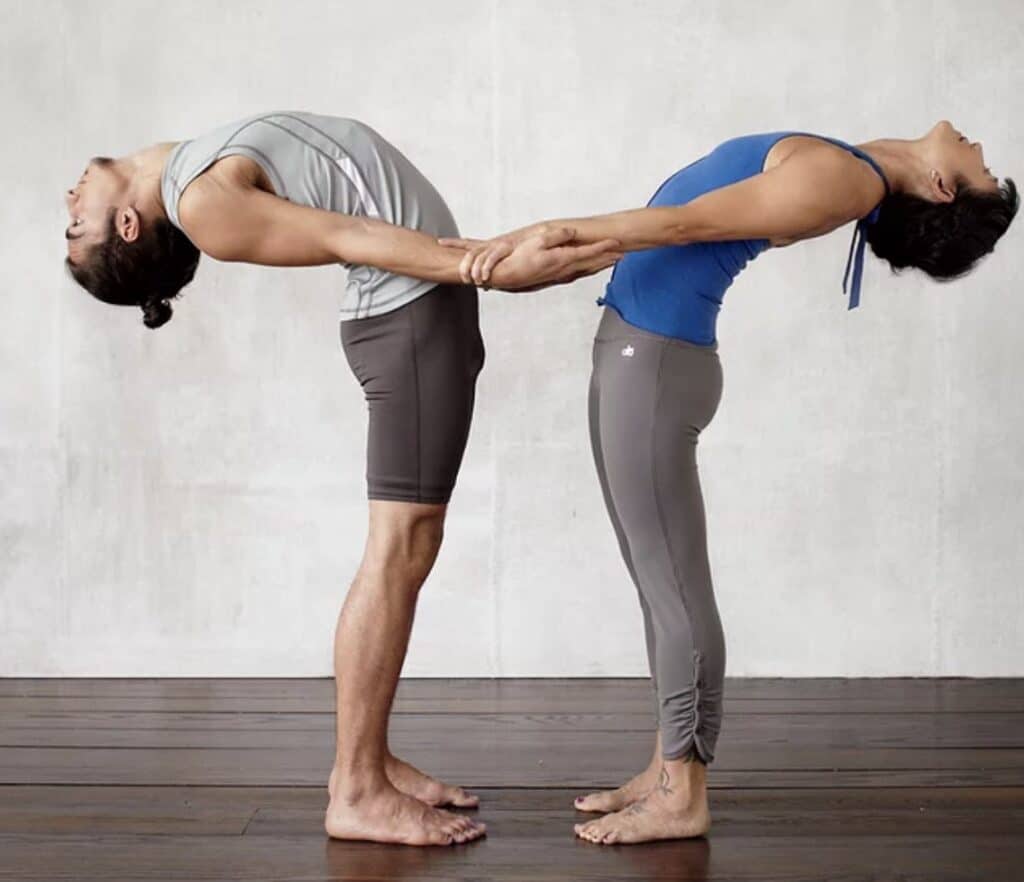
Face your partner and grab onto their forearms, hands, or wrists. Inhale and stand tall, actively pushing the four corners of your feet into the ground. Engage your core.
Keeping space in the low back, slowly start to drop into a backbend. You can release the head if there’s no neck pain or just keep the neck neutral.
Use your partner for balance as you lengthen on each inhale and deepen into the backbend on every exhale. Notice if the shoulders are moving up towards the ears and drop them down.
13. Assisted Camel + Boat
Camel is a problematic yoga posture for many students. We want to expand through the chest — but without collapsing in the lower back.
What’s one of my top tricks for safely practicing camel pose? You guessed it: via yoga for two people.
Sit up on your knees with your feet behind you. Engage the core. On the exhale, actively engage the thighs like you’re pushing them into a wall in front of you. Begin to open the heart and lean back.
Behind you, your partner will take boat pose. Their feet come to your back, somewhere between your sacrum and shoulder blades. As your partner applies support to the lower back, grab onto your heels or a yoga block. If this is too much, ask your partner to hold your arms. Stay in this heart-opening posture for a few breaths or up to 30 seconds if it feels good. Switch.
14. Wide-Legged Forward Bend
For this two person yoga pose, head back to a seated position. Face one another and extend your legs wide. Keep your knees and toes pointed towards the ceiling. Your partner’s feet can come to rest on your ankles or vice versa. Hold hands.
As you work with the breath, begin to rock backwards and forward. When one partner folds forward, the other leans back. (And vice versa.)
Move slowly and intentionally. Stay in the forward fold for a few breaths before rocking back. Maybe notice you start to sink deeper into the fold each time.
15. Cobra Pose + Chair
Lie on your stomach with your legs together. Your partner will stand behind you, straggling your legs. Now, lift your head and chest, and bring your gaze up.
Your partner will hold your arms (as you keep your palms facing out) and sink into chair pose. With their body weight, they’ll peel your torso off the ground and into an assisted backbend. Don’t forget to breathe. Switch.
16. Reclined Butterfly Pose
When it comes to yoga poses for two people, it’s hard to beat the hip and chest opening benefits of this reclined butterfly pose!
Sit next to your partner and face opposite directions. Find butterfly pose; bring the soles of your feet together to make a diamond shape with your knees.
Start to recline on your partner’s right thigh. They’ll do the same. It’s okay if your other hip comes slightly off the ground. I like to rest my hands behind my head.
Breathe deeply into your heart center, allowing yourself to grow heavier as your right hip melts into the mat with each exhale. Grab hands with your partner to rise, and switch sides.
17. Double Plank
This pose is trickier than it looks, so don’t worry if you have to practice a bit to get there.
Come into a plank. Engage your core and squeeze your bum as you powerfully corkscrew your hands into the mat. Don’t let those shoulders shrug up towards the ears.
When you’re feeling strong, your partner will place their hands on your ankles, the tops of their feet on your shoulders.
If this is too much, practice plank next to one another until you’re ready to tackle the pyramid.
18. Assisted Handstand
Let’s put it right on the table: getting upside down is scary! But yoga helps us overcome our fears, and a fantastic way to practice handstands is with the support of a friend. These hard yoga poses for two people may be intimidating at first, but it’s highly beneficial. Place your hands on the ground, gaze slightly ahead. Push the ground away from you as you engage the core. From this robust and stable base, place one foot on your partner’s shoulder. Your partner will begin to walk forward, lifting your raised leg higher in the air. Your other foot might start to come off the ground — that’s what we want.
Bring your other foot up when your leg is nearly in line with your torso. (Ensure your partner isn’t in the way!)
Once you have your balance, your partner can fully release their grip. See how long you can balance without their help. Switch sides and roles.
19. Flyer + Base (Acroyoga)
I promised an Acroyoga pose for two people, so here it is…
…the foundation to more difficult Acroyoga postures and an all-time classic.
Think back to when you were a kid. Did your parents use their feet to lift you in the air like Superman? This is the same idea. And, spoiler alert — it’s just as fun as an adult!
Start by lying on your back, arms and legs extended into the air. Bend your knees a bit, so they come to rest on your partner’s hips. Now, grab their arms. Straighten your legs a bit as your partner leans forward and into a flying plank pose. Switch roles.
20. Savasana
Just because we’ve been practicing new partner yoga poses doesn’t mean we will not end class like every other — in Savasana!
Lie on your back next to your partner. Let go of any tension as you melt into the ground beneath you. Palms can face towards the sky. Or, you can hold your partner’s hand in gratitude for your practice together. Stay here as long as you both like.
Bonus Pose: Double Tree Pose
Double Tree Pose is great for improving balance. It can be performed face to face or with you and your partner facing the same direction.
If you’re side by side, your standing feet will be on the inside. Place your arms around each other’s waist and bring your hips together. From there, grow your tree. Bring your outside feet to the inside of your thigh or calf and bring your outside hands together into Anjali mudra.
To lengthen your side bodies, bring the mudra into the air above your heads. Take a deep breath in through your diaphragm, and then exhale fully.
Try Yoga Poses With a Partner Today
Yoga poses for two people are an easy way to add more play to your life — and more trust to your relationships.
Ready to deepen your yoga practice even further?
Imagine this dream scenario for a sec:
You’re seated in an open-air yoga studio overlooking the Pacific Ocean. You close your eyes and listen to the waves as they gently lap on the private beach just steps away.
You open your eyes to soak in your private oasis — one of the most biologically diverse places on the planet. A lush, tropical paradise where you can nourish your mind, body, and soul through thoughtful yoga classes, farm-to-table cuisine, and off-the-beaten-track Costa Rican adventures.
This is the Blue Osa experience. We’re honored to provide it to our guests, and we’d love to share it with you, too. Learn more today.


